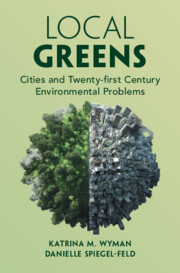Book contents
- Local Greens
- Local Greens
- Copyright page
- Dedication
- Contents
- Figures
- Tables
- Photographs
- Acknowledgments
- Introduction
- 1 A Brief History of Cities in Environmental Policy
- 2 An Analytical Framework
- 3 Local Environmental Protection in NYC
- 4 Decarbonization Efforts in NYC
- 5 Adapting to Climate Change in NYC
- 6 An Urban Climate Change Agenda for the Early Twenty-First Century
- Coda
- Notes
- Index
2 - An Analytical Framework
Published online by Cambridge University Press: 11 October 2025
- Local Greens
- Local Greens
- Copyright page
- Dedication
- Contents
- Figures
- Tables
- Photographs
- Acknowledgments
- Introduction
- 1 A Brief History of Cities in Environmental Policy
- 2 An Analytical Framework
- 3 Local Environmental Protection in NYC
- 4 Decarbonization Efforts in NYC
- 5 Adapting to Climate Change in NYC
- 6 An Urban Climate Change Agenda for the Early Twenty-First Century
- Coda
- Notes
- Index
Summary
This chapter outlines a framework for understanding what drives city governments in the early twenty-first century to engage in environmental protection efforts in the absence of mandates or generous subsidies from higher levels of government. The chapter begins by emphasizing is the central preoccupation at the local level with promoting economic growth, partly to fund the services that local governments provide, such as police and firefighting. The chapter distinguishes between two archetypal categories of environmental problems: local public goods problems, such as the need to collect solid waste or inadequate green space, that local residents benefit from addressing; and global public goods problems, such as planetary warming, that people throughout the world benefit from addressing. Local elites may push from “the top” for measures, such as building parks and collecting garbage, that simultaneously will improve the local environment and promote economic growth by making their cities more attractive to existing and new residents. In addition, community groups may push from “the bottom” for measures to improve the local as well as the global environment, such as limiting planetary warming. However, U.S. local governments are likely to resist imposing costs on local actors to address global environmental problems, such as limiting climate change, because of localities’ nested position as relatively small entities within a large federation competing for businesses and residents. Left to their own devices, local governments are more likely to undertake measures that will yield local benefits, such as improvements in the health of local residents and the beautification of the local environment. For cities to contribute meaningfully to addressing the global task of limiting planetary warming, local activists will need to mobilize over a sustained period to maintain the pressure on local officials who are sensitive to the need to cultivate local economic prosperity.
Keywords
Information
- Type
- Chapter
- Information
- Local GreensCities and Twenty-first Century Environmental Problems, pp. 25 - 35Publisher: Cambridge University PressPrint publication year: 2025
Accessibility standard: WCAG 2.0 A
Why this information is here
This section outlines the accessibility features of this content - including support for screen readers, full keyboard navigation and high-contrast display options. This may not be relevant for you.Accessibility Information
Content Navigation
Allows you to navigate directly to chapters, sections, or non‐text items through a linked table of contents, reducing the need for extensive scrolling.
Provides an interactive index, letting you go straight to where a term or subject appears in the text without manual searching.
Reading Order & Textual Equivalents
You will encounter all content (including footnotes, captions, etc.) in a clear, sequential flow, making it easier to follow with assistive tools like screen readers.
You get concise descriptions (for images, charts, or media clips), ensuring you do not miss crucial information when visual or audio elements are not accessible.
You get more than just short alt text: you have comprehensive text equivalents, transcripts, captions, or audio descriptions for substantial non‐text content, which is especially helpful for complex visuals or multimedia.
Structural and Technical Features
You gain clarity from ARIA (Accessible Rich Internet Applications) roles and attributes, as they help assistive technologies interpret how each part of the content functions.
